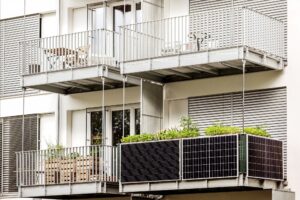New research is exploring how waste CO2 from building exhaust could be used as a kind of fertiliser to boost rooftop gardens.
Rooftop farms and gardens can cool the surrounding area, increase building insulation, and improve air quality, but plants are often smaller and less healthy due to increased sun and wind exposure and lesser soil moisture.
A team led by the University of Cambridge have grown corn and spinach on the roof of a campus building at Boston University to test whether repurposing waste CO2 could improve the plants health.
‘We wanted to test whether there is an untapped resource inside buildings that could be used to make plants grow larger in rooftop farms,’ said Dr Sarabeth Buckley, a Post-Doctoral Researcher at Cambridge University’s Department of Plant Sciences. ‘Creating more favourable conditions that increase growth could help make rooftop farms more successful and therefore more viable options for installation on buildings.’
Spinach and corn use different pathways to photosynthesize, with spinach using a C3 pathway which is more sensitive to elevated levels of CO2.
It was expected spinach would benefit more from the exhaust vents, while the corn acted as a control to see how else the vents affect plant growth.
Large fans were also placed in front of other control plants, to measure whether air movement from the vents was a contributing factor.
The researchers found spinach grown next to the exhaust vents had four times the biomass of spinach grown next to a control fan. Even when high winds decreased the size advantage, the plants were still twice as large as controls.
‘There are still many aspects of this system that must be determined before it can be implemented such as the optimal air application design and the possible extent of the enhanced growth effect,’ cautioned Buckley. ‘Also, there is a decrease in growth with increased wind speed, so the optimal wind speed would need to be found and incorporated into the system design.’
However, it doesn’t seem the change in size was wholly due to the influx of CO2, as the corn, which should have benefited less, also grew two to three times larger than the control plants.
The team, who published their work in Frontiers in Sustainable Food Systems, believe the study has important implications for how waste CO2 could be used to enhance plant growth.
‘We are hoping this could lead to the further development of this system and eventual implementation in rooftop gardens and farms,’ Buckley said. “If that happens, then hopefully more rooftop farms will be installed. They could provide a multitude of environmental and social benefits such as energy savings for the building, carbon drawdown, climate mitigation, urban heat reduction, local food production, community building opportunities, and aesthetic and mental health benefits.’
Photo by Jenna Beekhuis

















Leave a Reply